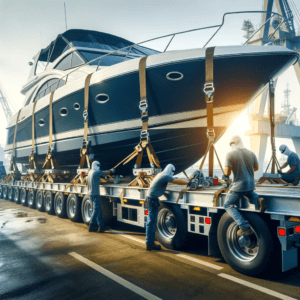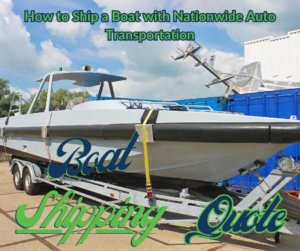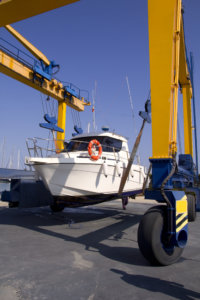
Reading Time: 15 minutes
Welcome aboard our yacht shipping and international boat shipping guide! I’m here to steer you through the exciting world of taking your vessel across global waters. Now, let’s set the scene: you’re a proud boat owner, ready for an adventure on the high seas.
But wait, before we get underway, there’s a key detail you need to consider – the ins and outs of international boat shipping.
Shipping a boat overseas may feel overwhelming, but don’t worry! With some smart preparation and the right know-how, you can sail through the process easily. To help you out, we’ve created this easy-to-follow guide, covering all you need to know about international boat shipping.
In this article:
- The Essentials of Documentation: Discover why proper paperwork is your passport to hassle-free shipping.
- Licensing and Regulations: Unravel the legal tape to stay compliant across different shores.
- Prepping Your Vessel: Tips on getting your boat ship-shape and ready for its big journey.
- Choosing Your Shipping Method: From RoRo to container shipping, find the perfect fit for your maritime mate.
- Partnering with a Shipping Company: Learn how the right experts can make a world of difference.
- Customs and Import Rules: Navigate the complexities of customs for a smooth sailing experience.
- Receiving Your Boat: The final stretch! Ensuring a smooth handover at your destination.
- Post-Shipping Care: Keep your boat in top condition after its international voyage.
Enjoy this comprehensive journey to guarantee that your boat’s international voyage is as smooth as the seas you dream of sailing!
So, whether you’re relocating, selling your boat to a buyer overseas, or simply embarking on an epic yacht adventure, sit back, relax, and sail into the world of international boat shipping.
Understanding International Boat Shipping
When it comes to shipping your boat internationally, there are a few key things you need to know to ensure a smooth and successful process. From understanding the importance of proper documentation to navigating licensing and regulations, this section will cover all the essential information you need to understand international boat shipping.

For a comprehensive overview of international shipping regulations, visit the International Maritime Organization for detailed guidelines.
International Boat Shipping Guide | An Overview
Shipping a boat internationally involves transporting your vessel from one country to another. Whether you’re relocating, selling, or simply need your boat in another location, international boat shipping offers a convenient solution.
Importance of Proper Documentation
Proper documentation is critical when it comes to international boat shipping. Here are some essential documents you need to prepare:
- Bill of Sale: This document proves ownership of the boat and is required for customs clearance.
- Certificate of Origin: This document verifies where the boat was built and helps determine trade restrictions or duties.
- Notarized Power of Attorney: If you won’t be present during the shipping process, a power of attorney gives someone else the authority to act on your behalf.
- Insurance Documents: It’s crucial to have insurance coverage for your boat during the shipping process.

Deepen your understanding of maritime shipping with our comprehensive guide on Boat Shipping Terminology. This resource is perfect for anyone looking to navigate the complex world of boat transport with ease. Whether you’re a first-time shipper or seasoned pro, our guide demystifies key terms and concepts, making your shipping experience smoother.
Licensing and Regulations
Different countries have specific licensing and regulations when it comes to importing boats. It’s essential to research and understand the requirements of both the origin and destination countries. Here are a few key considerations:
- Boat Size Restrictions: Some countries may have restrictions on the size of boats that can be imported.
- Environmental Regulations: Make sure your boat complies with environmental regulations, such as proper disposal of waste or fuel.
- Import Taxes and Duties: Be aware of any import taxes or duties that may apply in the destination country.
Understanding and complying with these licensing and regulations is crucial to prevent any delays or complications during the shipping process.
Remember, it’s always a good idea to reach out to a professional boat shipping company that specializes in international shipping. They can guide you through the process and ensure all the necessary documentation and licensing requirements are met.

“Proper documentation is crucial when it comes to international boat shipping. Make sure you have all the necessary documents in order to avoid any delays or complications.”
Nationwide Auto Transportation – International Boat Shipping Guide
International Boat Shipping Guide | How to Prepare
When it comes to international boat shipping, proper preparation is key. Taking the necessary steps to prepare your boat before shipping can help ensure a smooth and successful shipping process. Here are some important things to consider when preparing your boat for shipping:
Cleaning and Inspection

Before shipping your boat, it is essential to thoroughly clean and inspect it. This not only helps maintain the condition of your boat but also ensures that it complies with international shipping regulations. Here’s what you need to do:
- Remove all personal belongings, including equipment, accessories, and any loose items.
- Give your boat a thorough cleaning, both inside and out, to remove any dirt, grime, or residues.
- Check for any damages or existing issues, such as cracks, leaks, or mechanical problems.
- Take detailed photographs of your boat’s current condition for insurance purposes.
Taking Inventory of Equipment and Accessories
It is important to create an inventory of all the equipment and accessories that are being shipped with your boat. This helps ensure that nothing gets lost or damaged during transit. Here’s how you can do it:
- Make a list of all the equipment, accessories, and personal items you have removed from your boat.
- Take photographs of each item and include relevant details, such as brand, model, and serial numbers.
- Consider labeling each item with a corresponding number or code for easy identification.
Securing Loose Items
To prevent any damage to your boat or other items during shipping, it is crucial to secure any loose or detachable components. Here are some tips for securing loose items:

- Remove any detachable parts, such as electronics, antennas, or fishing gear, and pack them separately in secure containers.
- Secure all hatches, doors, and windows to prevent them from opening during transport.
- Cover any exposed or vulnerable areas of your boat to protect them from potential damage during shipping.
By following these steps, you can ensure that your boat is properly prepared for shipping and minimize the risk of any damage or loss during transit. Remember, proper preparation is the key to a successful international boat shipping experience.
International Boat Shipping Guide | Choosing the Right Method
When it comes to international boat shipping, choosing the right shipping method is crucial to ensure the safe and efficient transportation of your prized possession. With various options available, it’s essential to understand each method’s advantages and considerations before making a decision. Let’s take a closer look at some of the popular shipping methods for transporting boats internationally.
International Boat Shipping Guide | Roll-on/Roll-off (RoRo) Shipping

- What is it? RoRo shipping involves loading and unloading your boat onto specialized trailers or platforms that are rolled onto the vessel. This method is commonly used for large boats or yachts.
- Advantages:
- Cost-effective option
- Quicker turnaround time
- Minimal handling and risk of damage
- Considerations:
- Limited to certain ports with RoRo facilities
- Not suitable for boats with fixed masts or extensive modifications
Container Shipping

- What is it? Container shipping involves placing your boat inside a shipping container for transportation. This method provides protection from the elements and added security during the journey.
- Advantages:
- Protection from weather conditions
- Versatile option for various boat sizes
- Additional space in the container for equipment or accessories
- Considerations:
- Requires cranes or forklifts for loading and unloading
- Costlier compared to RoRo shipping
Flat Rack Shipping | International Boat Shipping Guide
- What is it? Flat rack shipping involves securing your boat onto a flat rack container, which is essentially a flatbed with collapsible sides. This method accommodates larger boats or boats with unique dimensions.
- Advantages:
- Suitable for boats with unconventional sizes
- Easy loading and unloading using cranes
- Considerations:
- Limited availability of flat rack containers
- Increased risk of exposure to weather conditions
Before selecting a shipping method, consider the size, shape, and specific requirements of your boat. Additionally, you should also take into account factors such as budget, timeline, and the available facilities at the origin and destination ports. Consulting with a reputable boat shipping company can help you make an informed decision based on your unique circumstances.
Pro Tip: No matter which shipping method you choose, remember to properly secure your boat by using professional-grade straps, braces, or cradles. This will help prevent any movement or damage during transit.
NAT Professional Shipping
Choosing the right shipping method is an important step in the international boat shipping process. By understanding the advantages and considerations of each method, you can see to the smooth and successful transportation of your boat to its destination.
Working with a Yacht Shipping Company

When it comes to yacht shipping, or shipping your boat internationally, finding the right boat shipping company is crucial. Working with a reliable and experienced company will ensure that your boat is transported safely and efficiently to its destination. Here are some key factors to consider when choosing a boat shipping company:
Researching and Vetted Companies
Before entrusting your boat to a shipping company, it’s essential to do thorough research. Look for companies that specialize in boat shipping and have a proven track record of successful deliveries. Here are some tips for researching and vetting companies:
- Read customer reviews: Check online platforms and forums for reviews and testimonials from previous customers. This will give you insights into the company’s reputation and the quality of their services.
- Ask for recommendations: Reach out to fellow boat owners or boating communities for recommendations. They may have valuable insights based on their own experiences.
- Verify licensing and certifications: Ensure that the company is properly licensed and certified to handle international boat shipments. Ask for proof of their qualifications and affiliations with industry organizations.
Comparing Quotes
It’s always a good idea to request quotes from multiple boat shipping companies to compare prices and services. Here are some points to keep in mind when comparing quotes:
- Get detailed quotes: Make sure that the quotes you receive are comprehensive and include all the necessary services, such as pickup, transport, and delivery.
- Consider the level of service: Take into account the level of customer service offered by each company. Are they prompt and responsive to your inquiries? Do they provide clear communication throughout the shipping process?
- Beware of lowball quotes: While it can be tempting to choose the cheapest option, be cautious of quotes that are significantly lower than others. Extremely low prices may indicate subpar service or hidden fees.

International Boat Shipping Guide | Yacht Shipping Insurance Coverage
When shipping a valuable asset like a boat, it’s essential to ensure adequate insurance coverage. Accidents and damages can happen during transit, and having insurance will protect you financially. Here’s what you need to know about insurance coverage:

- Verify insurance coverage: Check if the yacht shipping company offers insurance coverage for your boat during transport. Additionally, find out the extent of coverage and any exclusions or limitations.
- Consider additional insurance: Depending on the value of your boat, you may want to consider purchasing additional insurance coverage to fully protect your investment.
- Review the claims process: Familiarize yourself with the company’s claims process in case any damages occur during shipping. Understand what documentation and evidence are required to file a claim.
By following these tips, you can confidently choose a yacht shipping company that meets your needs and ensures a smooth and secure shipping process for your boat. Remember, a reputable and reliable company will provide you with peace of mind knowing that your boat is in capable hands.
Looking for more insights on auto transportation? Dive into our comprehensive blog for expert advice, tips, and the latest trends in vehicle shipping. Whether it’s boat, car, or RV transport, find everything you need to know!
Navigating Customs and Import Regulations
When it comes to international boat shipping, one of the most important aspects to consider is navigating customs and import regulations. These regulations can vary from country to country, so it’s crucial to understand the process and requirements before shipping your boat. In this section, we will discuss the key points you need to know about navigating customs and import regulations for international yacht shipping.
Understand country-specific customs requirements by checking the U.S. Customs and Border Protection for the latest information.
Customs Documentation and Declarations
To ensure a smooth customs clearance process, it’s essential to have all the necessary documentation and declarations in order. Here are some important documents you may need:
- Bill of Lading: This document serves as proof of ownership and provides details about the boat, its value, and the terms of shipment.
- Certificate of Origin: Some countries may require a certificate of origin to verify where the boat was manufactured.
- Commercial Invoice: This document provides a detailed description of the boat, including its value, for customs purposes.
- Import License: Certain countries may require an import license before you can bring in a boat, especially if it’s a commercial vessel.
- Customs Forms: Each country has its own customs forms that need to be completed accurately and submitted prior to shipping.
It’s crucial to work closely with your yacht shipping company or a customs broker to ensure that you have the correct documentation and that it is filled out correctly. Any errors or missing information can cause delays and additional costs. That said, here are some more Shipper Tips!

Duties, Taxes, and Fees
When importing a boat, you may be subject to paying duties, taxes, and other fees imposed by the importing country. These charges can vary depending on factors such as the boat’s value, age, and purpose (commercial or personal use). Here are a few key points to keep in mind:
- Import Duties: These are taxes imposed by the government on imported goods and are often based on the boat’s value.
- Value Added Tax (VAT): VAT is a consumption tax applied to the boat’s value and can vary from country to country.
- Harbor Fees: Some ports may charge harbor or port fees, which can include items like dockage, handling, and storage fees.
- Customs Clearing Fees: Customs clearing fees cover the cost of processing your boat through customs and may vary by country.
It’s crucial to research and understand the specific duties, taxes, and fees that apply to your destination country. This will help avoid any surprises or unexpected expenses when your boat arrives.
Restricted and Prohibited Items
It’s important to be aware of any restrictions or prohibitions on importing certain items into your destination country. These can include specific equipment, accessories, or even certain types of boats. Here are some examples of restricted and prohibited items:
- Firearms or ammunition
- Controlled substances or illegal drugs
- Endangered species or products made from them (ivory, certain types of wood, etc.)
- Hazardous materials or substances
- Certain types of marine equipment (radar jammers, underwater breathing apparatus, etc.)

Make sure to familiarize yourself with the customs regulations of your destination country and consult with your shipping company or customs broker to ensure compliance.
By understanding and following the customs and import regulations, you can navigate the process of international boat shipping smoothly and efficiently. Working with a reputable yacht shipping company and staying informed will help ensure a successful and hassle-free shipment.
“Navigating customs and import regulations is crucial when shipping your boat internationally. Make sure you have all the necessary documentation, understand the duties and fees, and comply with any restrictions or prohibitions to avoid delays and additional costs.”
Nationwide Auto Transportation
Delivery and Receiving Your Boat | International Boat Transport
Getting your boat safely delivered to its final destination is the ultimate goal of international boat shipping. Once your boat arrives at the designated port, it’s important to follow certain steps to ensure a smooth and hassle-free delivery. In this section, we will discuss the key aspects of delivery and receiving your boat after it has been shipped.
Tracking and Monitoring Shipment
- Stay updated: Throughout the yacht shipping process, it’s crucial to stay in touch with the shipping company to receive regular updates on the status of your boat. This will help you plan your logistics accordingly and be prepared for the arrival.
- Tracking options: Most reputable boat shipping companies offer advanced tracking systems that allow you to monitor your boat’s journey in real-time. Whether it’s through an online portal or mobile app, tracking your shipment can provide peace of mind and keep you informed.
- Communication is key: Maintain open lines of communication with the yacht shipping company and make sure you have clear contact details for the point of contact at the port of destination. This will allow you to stay connected and obtain vital information about the arrival time and any potential delays.

Inspection upon Delivery
- Thorough inspection: Upon the arrival of your boat, it’s crucial to conduct a thorough inspection to ensure that there are no damages or missing items. Take note of any visible scratches, dents, or other damages that may have occurred during transportation.
- Documentation: Take pictures of any damages or irregularities, and make sure to document them in writing as well. This will be essential should you need to file a claim with the shipping company or insurance provider.
- Verify paperwork: Check that all the necessary paperwork, including the bill of lading and customs documentation, is in order and matches the details of your boat. Ensure that the boat’s identification numbers, such as the hull identification number (HIN), match the information on the paperwork.
Transportation to Final Destination
- Logistics planning: Prior to shipping your boat, make sure you have a plan in place for the transportation of your boat from the port of destination to its final location. Consider whether you will need to hire a professional boat transporter or if you will handle the transport yourself.
- Local regulations: Familiarize yourself with the local regulations and requirements for transporting boats on land. Some areas may require special permits or restrictions, such as width or weight limitations. Research and adhere to these regulations to avoid any legal issues or complications.
- Professional assistance: If you decide to hire a professional boat transporter, make sure to choose a reputable and experienced company. They will have the necessary equipment and expertise to safely transport your boat to its final destination.
Remember, proper planning and attention to detail are key when it comes to delivery and receiving your boat after international yacht shipping. By following these steps, you can ensure a smooth and successful handover of your boat, allowing you to start enjoying your watercraft in its new location.
“The arrival of your boat after international shipping is an exciting moment. Ensure a smooth handover by staying informed, conducting a thorough inspection, and planning for the transportation to its final destination.”
Maintenance and Care After Yacht Shipping

Once your boat has arrived at its destination, it’s important to properly maintain and care for it to ensure its longevity and performance. Here are some key maintenance and care steps to take after yacht shipping:
Inspecting for Damages
- Inspect your boat thoroughly upon its arrival. Look for any damages or signs of wear and tear that may have occurred during shipping.
- Check the hull, propellers, and other external components for any dents, scratches, or dings.
- Inspect the interior of the boat as well, paying close attention to the electrical system, plumbing, and any other mechanical components.
For best practices on boat maintenance post-transport, explore resources provided by the American Boating Association.
Cleaning and Detailing
- Clean your boat both inside and out to remove any dirt, dust, or residue that may have accumulated during transit.
- Use gentle cleaning solutions and non-abrasive materials to avoid damaging the boat’s surfaces.
- Consider getting your boat detailed to restore its shine and protect its paint and finish.
Servicing and Repairs

- Schedule a maintenance check-up with a qualified marine technician or boat mechanic. They can inspect the boat’s engine, electrical systems, and other crucial components.
- Address any necessary repairs promptly to avoid further damage or issues down the line.
- If your boat has been out of commission for an extended period, it may be beneficial to change the fluids and perform necessary engine maintenance before taking it out on the water.
Proper maintenance and care are crucial for the longevity and performance of your boat, especially after it has been shipped internationally. By inspecting for damages, cleaning and detailing, and addressing any necessary repairs, you can ensure that your boat is in top shape and ready for its next adventure on the water.
Drop the Anchor | International Boat Shipping Guide
As we navigate to the end of our international boat shipping journey, remember, the key to a successful voyage is meticulous preparation, a deep understanding of global regulations, and partnering with a trusted shipping expert. Here’s a quick recap of your essential guide to smooth sailing:
- Master the Documentation: Know your papers inside and out.
- Navigate Legal Waters: Stay updated on international regulations.
- Prepare Your Vessel: A well-prepped boat is a happy traveler.
- Select the Right Shipping Lane: Choose the method that suits your boat best.
- Inspect on Arrival: Give your boat the welcome it deserves.
Don’t let the details of international boat shipping rock your boat. Nationwide Auto Transportation is here to steer you through. We’re not just about shipping; we’re about ensuring your vessel’s journey is as smooth as your dreams. Ready to embark on this adventure? Get a boat shipping quote from Nationwide today and set sail with confidence!
Beyond the seas, Nationwide Auto Transportation also offers a fleet of services tailored for every traveler:
- 🚙 Car Shipping: Trusted and timely transport for your four-wheeled friend.
- 🏍️ Motorcycle Transport: Safe and secure journeys for your two-wheeled pride.
- 🚐 RV Transport: Exploring the highways and byways with your home on wheels.
- 🚛 Truck Shipping: Reliable transport for when you need more muscle.
- ⏱️ Expedited Transport: For when time is as precious as your cargo.
Your vessel deserves the best. Choose Nationwide Auto Transportation for a voyage that’s as seamless as the ocean breeze. Let’s set sail together!
Visit Nationwide Auto Transportation’s Auto Shipping Guide for an in-depth look at navigating the post-pandemic auto shipping landscape. Discover how COVID-19 has transformed the auto industry, from shifts in consumer behavior to the rise of new technologies. Learn about the challenges and opportunities in auto shipping today and find expert insights for your shipping needs.
International Boat Shipping Guide | Frequently Asked Questions
- What is international boat shipping?
International boat shipping refers to the process of transporting boats or watercraft from one country to another. It involves various logistics and considerations to ensure the safe and secure delivery of the boat.
- What are the documents required for international boat shipping?
The required documents for international boat shipping may vary depending on the countries involved. Generally, you will need the original boat title, bill of sale, proof of ownership, passport, and other customs documentation.
- How long does it take to ship a boat internationally?
The duration of international boat shipping depends on several factors, including the distance between the origin and destination, customs procedures, weather conditions, and shipping method. It can range from a few weeks to several months.
- What are the different methods of international boat shipping?
There are three common methods of international boat shipping: Roll-on/Roll-off (RoRo) shipping, container shipping, and flat rack shipping. Each method has its own advantages and considerations, depending on the size and type of the boat.
- How much does international boat shipping cost?
The cost of international boat shipping can vary based on factors such as the size and weight of the boat, shipping method, destination, customs fees, and insurance coverage. It is best to request quotes from shipping companies to get an accurate estimate.



